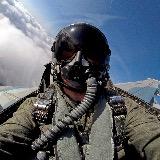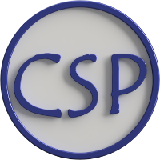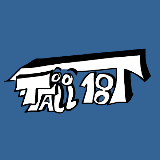Probe Basic - How does tool setter calculate ?
- karnalta
- Offline
- Senior Member
-

Less
More
- Posts: 66
- Thank you received: 11
23 Dec 2024 12:36 #317192
by karnalta
Probe Basic - How does tool setter calculate ? was created by karnalta
Hi all,
I am currently setting up Probe Basic for my machine which has 3D probe and tool length setter.
But I don't understand how it's gonna work :
- I set the X Y Z origin on my piece using the 3D probe.
- Then I measure the tool using the tool setter and it set an offset value to the tool (from the Z absolute zero of the machine).
But how does this tool offset work with the Z origin on the piece without knowing the 3D probe height ?
In QtDragon, you probe the Z of your piece and the Z of the tool setter, so it can use that difference in Z.
Thank for help.
I am currently setting up Probe Basic for my machine which has 3D probe and tool length setter.
But I don't understand how it's gonna work :
- I set the X Y Z origin on my piece using the 3D probe.
- Then I measure the tool using the tool setter and it set an offset value to the tool (from the Z absolute zero of the machine).
But how does this tool offset work with the Z origin on the piece without knowing the 3D probe height ?
In QtDragon, you probe the Z of your piece and the Z of the tool setter, so it can use that difference in Z.
Thank for help.
Please Log in or Create an account to join the conversation.
- zmrdko
-

- Offline
- Elite Member
-

Less
More
- Posts: 184
- Thank you received: 49
23 Dec 2024 15:52 #317205
by zmrdko
Replied by zmrdko on topic Probe Basic - How does tool setter calculate ?
Probe is basically tool like any other - so it can have its offset as well.
So you can either measure the 3d probe at first and then, when you measure the actual tool, the difference is accounted for and you are good to go.
you are not right about the offset value of the tool - it is measured actually from the spindle, but it's not that important.
alternatively, you can measure x and y with probe and then change the tool for the first used and touch the top of the stock with it.
So you can either measure the 3d probe at first and then, when you measure the actual tool, the difference is accounted for and you are good to go.
you are not right about the offset value of the tool - it is measured actually from the spindle, but it's not that important.
alternatively, you can measure x and y with probe and then change the tool for the first used and touch the top of the stock with it.
Please Log in or Create an account to join the conversation.
- Lcvette
-

- Offline
- Moderator
-

Less
More
- Posts: 1523
- Thank you received: 722
23 Dec 2024 16:04 #317207
by Lcvette
Replied by Lcvette on topic Probe Basic - How does tool setter calculate ?
depends completely on your machine setup, probe basic's stock tool setter functionality is designed for repeatable length tool holders where the tool length offset will repeat when the tool is loaded. think CAT40 or BT40 or TTS type tool holders. in this regard the probe will also have its own tool length offset. the tool setter is used for initial measuring of the tools and is designed to be stationary on the table with a known distance from the spindle nose (gage line) to the tool setter triggered height. when a tool is then measured its length offset will be the difference between the spindle noses (gage line) distance to the tool setter's triggered height and the height recorded when the inserted tool triggeres the tool setter. this give the tools an actual tool length offset in relation to the spindle nose.
when using the touch probe you would be probing with the tool length offset for the touch probe active. when the surface is probed and the probed point recorded, the work offset is zeroed. when the probe is removed from the spindle and its length offset cancelled, the new current distance of the spindle nose above the work origin will change.
this method is useful as it uses a non moving standard for the length offset measurement point, the spindle nose. this is more useful for machines with many tools that have stored length offsets in the tool table. with this method, if you crash a probe and need to replace the stylus, all of the other tools are not tied to the probe acting as a master tool which will now need remeasuring. instead the probes tool length offset is the only thing that must be updated and all other tools will have no impact to their recorded length offsets.
for routers with non repeatable tool lengths in yay an er collet for instance, this method does not work.
do please give us additional information about your machine setup so we can better understand which method would be best suited for you to implement.
thanks,
Chris
when using the touch probe you would be probing with the tool length offset for the touch probe active. when the surface is probed and the probed point recorded, the work offset is zeroed. when the probe is removed from the spindle and its length offset cancelled, the new current distance of the spindle nose above the work origin will change.
this method is useful as it uses a non moving standard for the length offset measurement point, the spindle nose. this is more useful for machines with many tools that have stored length offsets in the tool table. with this method, if you crash a probe and need to replace the stylus, all of the other tools are not tied to the probe acting as a master tool which will now need remeasuring. instead the probes tool length offset is the only thing that must be updated and all other tools will have no impact to their recorded length offsets.
for routers with non repeatable tool lengths in yay an er collet for instance, this method does not work.
do please give us additional information about your machine setup so we can better understand which method would be best suited for you to implement.
thanks,
Chris
Please Log in or Create an account to join the conversation.
- karnalta
- Offline
- Senior Member
-

Less
More
- Posts: 66
- Thank you received: 11
23 Dec 2024 18:36 #317214
by karnalta
My machine is an ER11 collet, so tool need to be measured again at each change.
My worry is that the actual method rely heavily on an accurate Z axis reference. When designing the machine, for me, end switch where just approximate boundaries to avoid crashes. So my Z end stop is just an Omron click switch . Repeatability is good when doing it back to back, but I am not confident over months period.
That's what my previous workflow was to probe work piece Z zero and tool setter height at each startup. Maybe I should apply same here, probe spindle height at each startup. Or maybe upgrade Z reference switch to something more precise.
Replied by karnalta on topic Probe Basic - How does tool setter calculate ?
Thank you for your response.depends completely on your machine setup, probe basic's stock tool setter functionality is designed for repeatable length tool holders where the tool length offset will repeat when the tool is loaded. think CAT40 or BT40 or TTS type tool holders. in this regard the probe will also have its own tool length offset. the tool setter is used for initial measuring of the tools and is designed to be stationary on the table with a known distance from the spindle nose (gage line) to the tool setter triggered height. when a tool is then measured its length offset will be the difference between the spindle noses (gage line) distance to the tool setter's triggered height and the height recorded when the inserted tool triggeres the tool setter. this give the tools an actual tool length offset in relation to the spindle nose.
when using the touch probe you would be probing with the tool length offset for the touch probe active. when the surface is probed and the probed point recorded, the work offset is zeroed. when the probe is removed from the spindle and its length offset cancelled, the new current distance of the spindle nose above the work origin will change.
this method is useful as it uses a non moving standard for the length offset measurement point, the spindle nose. this is more useful for machines with many tools that have stored length offsets in the tool table. with this method, if you crash a probe and need to replace the stylus, all of the other tools are not tied to the probe acting as a master tool which will now need remeasuring. instead the probes tool length offset is the only thing that must be updated and all other tools will have no impact to their recorded length offsets.
for routers with non repeatable tool lengths in yay an er collet for instance, this method does not work.
do please give us additional information about your machine setup so we can better understand which method would be best suited for you to implement.
thanks,
Chris
My machine is an ER11 collet, so tool need to be measured again at each change.
My worry is that the actual method rely heavily on an accurate Z axis reference. When designing the machine, for me, end switch where just approximate boundaries to avoid crashes. So my Z end stop is just an Omron click switch . Repeatability is good when doing it back to back, but I am not confident over months period.
That's what my previous workflow was to probe work piece Z zero and tool setter height at each startup. Maybe I should apply same here, probe spindle height at each startup. Or maybe upgrade Z reference switch to something more precise.
Please Log in or Create an account to join the conversation.
- Lcvette
-

- Offline
- Moderator
-

Less
More
- Posts: 1523
- Thank you received: 722
23 Dec 2024 20:46 #317227
by Lcvette
Replied by Lcvette on topic Probe Basic - How does tool setter calculate ?
in that case you would want to utilize a different subroutine, there are several good ones out there, if you liked the one from qtdragon you can see if it was a subroutine, or check with the router guys, they use some good methods that would be more akin to your requirements
Please Log in or Create an account to join the conversation.
- daveyr
- Offline
- Junior Member
-

Less
More
- Posts: 29
- Thank you received: 12
24 Dec 2024 20:35 #317298
by daveyr
Replied by daveyr on topic Probe Basic - How does tool setter calculate ?
I am a router guy  and what i am doing is not recommended by anyone with an actual mill but is close enough for me. (Er20 router non-repeatable)
and what i am doing is not recommended by anyone with an actual mill but is close enough for me. (Er20 router non-repeatable)
The spring on my tool setter is reasonably soft so it is able to trigger before my probe would.
So for each time i run / change jobs i load my Probe but don't connect it (tool 99) Probe the length of the tool setter just like it is any other tool.
Then connect probe and probe xyz as needed using the standard probe basic probe screen. At this stage the system now knows xyz of what is my stock.
Then change to what ever tool is needed for the job and probe that length. It calculates the difference between and off we go.
I find that i am within .01 - 0.03 mm using this method and for a router on Aluminum this close enough for my needs.
The tool change i use is based off GitHub - TooTall18T/tool_length_probe: Tool length probe subroutine for Probe Basic. and V3.0 if you have upgraded to the latest probe basic you may need something slightly different. It seems to work for me still in the latest build of probe basic but i have done a number of customizations that i need to un-do to get back to standard
The spring on my tool setter is reasonably soft so it is able to trigger before my probe would.
So for each time i run / change jobs i load my Probe but don't connect it (tool 99) Probe the length of the tool setter just like it is any other tool.
Then connect probe and probe xyz as needed using the standard probe basic probe screen. At this stage the system now knows xyz of what is my stock.
Then change to what ever tool is needed for the job and probe that length. It calculates the difference between and off we go.
I find that i am within .01 - 0.03 mm using this method and for a router on Aluminum this close enough for my needs.
The tool change i use is based off GitHub - TooTall18T/tool_length_probe: Tool length probe subroutine for Probe Basic. and V3.0 if you have upgraded to the latest probe basic you may need something slightly different. It seems to work for me still in the latest build of probe basic but i have done a number of customizations that i need to un-do to get back to standard
Please Log in or Create an account to join the conversation.
- onceloved
-

- Offline
- Premium Member
-

Less
More
- Posts: 130
- Thank you received: 58
30 Dec 2024 07:11 #317655
by onceloved
Replied by onceloved on topic Probe Basic - How does tool setter calculate ?
You can watch this video
The following user(s) said Thank You: Lcvette
Please Log in or Create an account to join the conversation.
- TooTall18T
-

- Offline
- Senior Member
-

Less
More
- Posts: 50
- Thank you received: 37
04 Jan 2025 12:35 #318056
by TooTall18T
Replied by TooTall18T on topic Probe Basic - How does tool setter calculate ?
When you need to measure your tools after each change, like me, you could use my subroutine (for Probe Basic up to 0.5.4: github.com/TooTall18T/tool_length_probe / for Probe Basic 0.6.0 github.com/TooTall18T/tool_length_probe/tree/develop).
Or for Probe Basic 0.6.0 you could also do that:
M6 Tx
o<tool_touch_off> call
That starts the tool measuring routine from Probe Basic after the tool change.
For Probe Basic 0.5.4 and lower it is not that easy. I would then recommend to my routine. Otherwise you would have to maintain the settings twice.
Or for Probe Basic 0.6.0 you could also do that:
M6 Tx
o<tool_touch_off> call
That starts the tool measuring routine from Probe Basic after the tool change.
For Probe Basic 0.5.4 and lower it is not that easy. I would then recommend to my routine. Otherwise you would have to maintain the settings twice.
The following user(s) said Thank You: Lcvette
Please Log in or Create an account to join the conversation.
- Lcvette
-

- Offline
- Moderator
-

Less
More
- Posts: 1523
- Thank you received: 722
06 Jan 2025 13:46 #318219
by Lcvette
Replied by Lcvette on topic Probe Basic - How does tool setter calculate ?
I would recommend to only use the latest versions for fixes are pushed regularly now on them and the methods used to pass variables will work in all circumstances of call, for example in remap the parameters from the ui were not accessible, the later versions used the var file which makes them available in remap also.
Please Log in or Create an account to join the conversation.
Moderators: KCJ, Lcvette
Time to create page: 0.531 seconds
